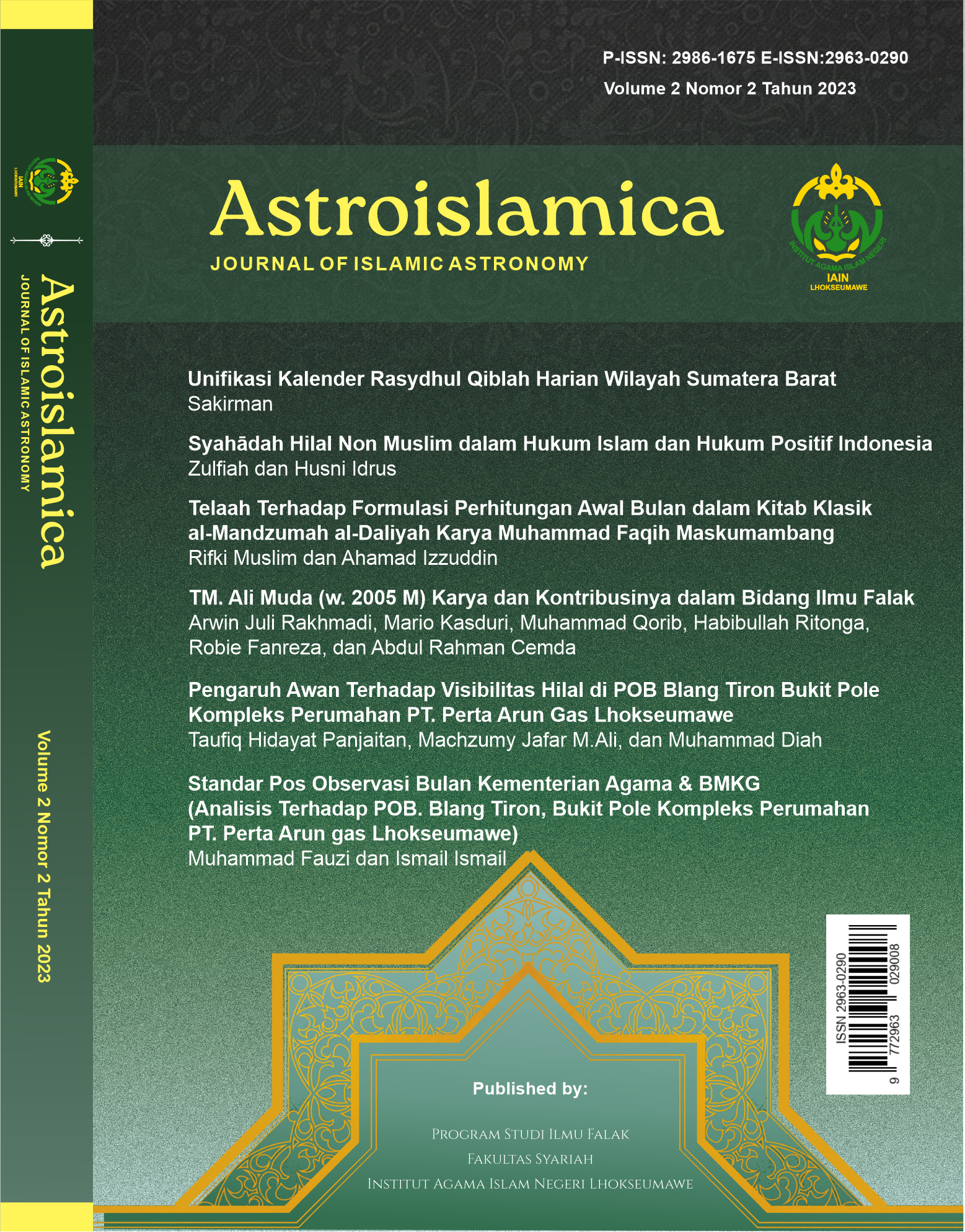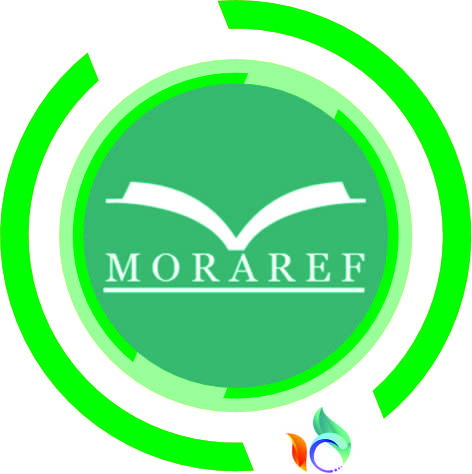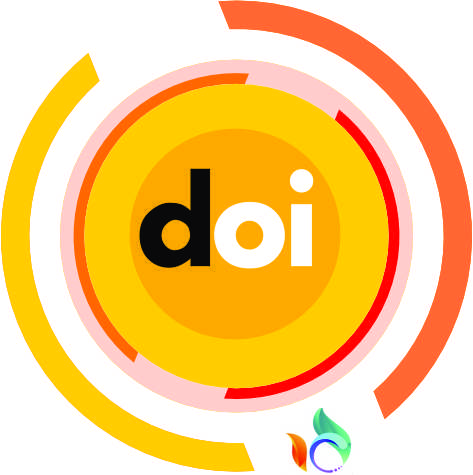Unifikasi Kalender Rasydhul Qiblah Harian Wilayah Sumatera Barat
DOI:
https://doi.org/10.47766/astroislamica.v2i2.1701Keywords:
azimuth, district, Rashdul Qiblah, sun, west SumateraAbstract
Part of one of the obligatory conditions that must be fulfilled when Muslims perform the prayer service is facing the face and all members of the body towards the Qibla. The main problem with Qibla's direction is the long distance between the Kaaba and the mosque as a place of worship for Muslims. West Sumatra is an area thick with religious nuances, there are many mosques as places of worship for Muslims. So, the Qibla direction of the mosque must be accurate with the Kaaba. One method that can be used is to use the sun's shadow reflected by an object. The utilization of sunlight in determining the Qibla direction with this model is known as Rashdul Qiblah. This paper examines the importance of the unification of the Rasydhul Qiblah calendar with the central point of the district capital and the center of the regional capital of West Sumatra. The validity of the rashdul qiblah calendar at the center of the regency capital in the West Sumatra region can be used by the districts within it. This type of research is field research using a descriptive-analytical model. The results of a study of areas located in the center of the district capital of West Sumatra show that the timing of the implementation of the rashdul qiblah for the districts covering the center of the district capital has a time difference that can still be tolerated.
References
Fathurahman, Fajar. “Innovative Development of Mobile Application for Qibla Direction Guidance Services Training.” Ilomata International Journal of Social Science 1, no. 3 (2020): 88–102. https://doi.org/10.52728/ijss.v1i3.122.
Ismail, Ismail. “Standar Operasional Prosedur (SOP) Kalibrasi Arah Kiblat Masjid Di Era Digital.” Al-Marshad: Jurnal Astronomi Islam Dan Ilmu-Ilmu Berkaitan 5, no. 1 (2019): 90–110. https://doi.org/10.30596/jam.v5i1.3126.
———. “Urgensi Dan Legitimasi Fatwa Majelis Permusyawaratan Ulama Aceh Nomor 3 Tahun 2018 Tentang Penetapan Arah Kiblat.” Al-Manahij: Jurnal Kajian Hukum Islam 14, no. 1 (June 2, 2020): 87–98. https://doi.org/10.24090/MNH.V14I1.3669.
Jamil, A., Sakirman, and Moelki Fahmi Ardliansyah. “Penentuan Arah Kiblat Dengan Posisi Matahari Di Pusat Ibu Kota Kabupaten Lampung.” Al-Manahij: Jurnal Kajian Hukum Islam 16, no. 1 (2022): 133–48. https://doi.org/10.24090/mnh.v16i1.6169.
John W. Creswell. Penelitian Kualitatif & Desain Riset Memilih Di Antara Lima Pendekatan. Yogyakarta: Pustaka Pelajar, 2013.
Lexy J. Moleong. Metodologi Penelitian Kualitatif. 35th ed. Bandung: PT Remaja Rosdakarya, 2016.
Mujab, Sayful. “Qiblat Tiap Saat Sebagai Jembatan Penentu Arah Qiblat.” Yudisia 6, no. 1 (2015): 160–80.
Muri Yusuf. Metode Penelitian Kuantitatif, Kualitatif & Penelitian Gabungan. Jakarta: Penerbit Kencana, 2014.
Sakirman, Sakirman. “Formulasi Baru Arah Kiblat: Memahami Konsep Rasydul Kiblat Harian Indonesia.” Al-Qisthu: Jurnal Kajian Ilmu-Ilmu Hukum 16, no. 1 (March 31, 2018): 1. https://doi.org/10.32694/010440.
———. “KH. AHMAD DAHLAN DAN GERAKAN PELURUSAN ARAH KIBLAT DI INDONESIA.” Akademika: Jurnal Pemikiran Islam 17, no. 2 (2012): 1–17.
Sanjaya, W. S.M., D. Anggraeni, F. I. Nurrahman, W. G. Kresnadjaja, I. P. Dewi, Mira, H. Aliah, and L. Marlina. “Qibla Finder and Sholat Times Based on Digital Compass, GPS and Microprocessor.” In IOP Conference Series: Materials Science and Engineering, Vol. 288. Institute of Physics Publishing, 2018. https://doi.org/10.1088/1757-899X/288/1/012149.
Sriani, Santi Okta, and Laiyina Ukhti. “Uji Akurasi Arah Kiblat Menggunakan Fitur Kompas Kiblat Pada Aplikasi Quran Kemenag Versi 2.1.4.” Astroislamica: Journal of Islamic Astronomy 1, no. 2 (2022): 213–31. https://doi.org/10.47766/astroislamica.v1i2.951.
Sugiyono. Metode Penelitian Kombinasi (Mixed Methods). Bandung: Penerbit Alfabeta, 2012.
———. Metode Penelitian Pendidikan; Pendekatan Kuantitatif, Kualitatif, Dan R&D. Bandung: Alfabeta, 2010.
Downloads
Published
Issue
Section
License
Copyright (c) 2023 Sakirman Sakirman

This work is licensed under a Creative Commons Attribution-ShareAlike 4.0 International License.









